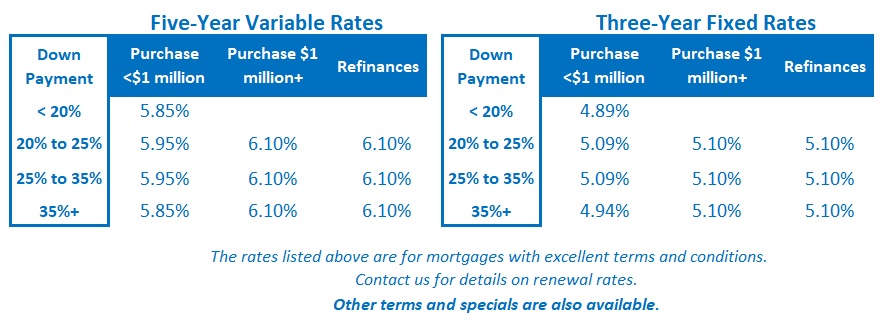Easing US Inflation is Good News for Canadian Mortgage Borrowers
July 15, 2024The Bank of Canada Cuts and Coos
July 29, 2024
Last week, Statistics Canada confirmed that our Consumer Price Index (CPI) increased by 2.7% in June on a year-over-year basis, down from 2.9% in May, and below the consensus forecast of 2.8%.
Our CPI also decreased by 0.1% on a month-over-month basis in June, reversing some of the 0.6% surge we saw in May.
With inflation now back on a downward path, bond-market investors are putting the odds of another 0.25% rate cut by the Bank of Canada (BoC) this Wednesday at about 95%.
The latest CPI data confirmed that our remaining inflation pressure is primarily driven by shelter costs, which accounted for about two thirds of last month’s headline increase. Shelter costs rose 6.2% year-over-year in June, driven higher by rents (+8.8%) and mortgage interest costs (+22.3%).
Interestingly, with mortgage interest costs excluded, our CPI decreased from 1.6% in May to 1.4% in June. (Hat tip to Ben Rabidoux for noting that.)
Mortgage interest costs rise and fall with the BoC’s policy rate, and additional rate cuts will directly alleviate the pressure on them. Under normal circumstances, the BoC would be concerned that lower rates would fuel inflation. But in today’s unusual circumstances, where shelter costs are the most significant contributor to inflation, that calculus changes.
In addition to reducing mortgage interest costs, a lower policy rate will help temper rent increases and facilitate an increase in residential construction, which will lower the cost of new homes.
The BoC can also be less concerned now that rate cuts will fuel a resurgence in speculative real-estate investment. Both Toronto and Vancouver are seeing their residential real-estate listings surge alongside declining sales. Far from inflaming our largest regional real-estate markets, more rate cuts may be needed just to stabilize them.
Last week’s consumer and business outlook surveys confirmed the impact that drum tight financial conditions are having on inflation expectations.
In its Canadian Survey of Consumer Expectations for Q2, the BoC noted that the expectations for inflation over the next 12 months “have declined significantly”.
That downshift was underpinned by “pessimism about future economic conditions” and expectations of “slower income growth” ahead. Canadian consumers are increasingly focused on reducing spending and paying off debt to reduce their elevated levels of financial stress.
The BoC noted that high interest rates were also top of mind: “Most consumers continue to report that past increases in interest rates will have an ongoing impact on their spending in the future … [and] nearly 80% said these impacts on their spending are just as or more severe than they were six months ago.”
The BoC’s Business Outlook Survey for Q2 reflected similar concerns about the weakening economy.
Canadian businesses remained “more pessimistic than average”, with businesses linked to discretionary spending reporting “particularly weak sales expectations”.
Investment spending plans “remain below average” because of “weak demand, elevated interest rates, uncertainty about the business environment, and the high cost of machinery and equipment.”
The number of firms reporting labour shortages came in “near survey lows”. Most businesses now expect “the growth of their input prices and selling prices to slow”, and “firms’ expectations for inflation fell in June and are now in the Bank of Canada’s inflation-control range.”
In summary, the BoC’s latest consumer and business surveys were decidedly downbeat and portend a further slowdown in economic momentum.
The bad news for the BoC is that the risk it may have overtightened has increased. The good news is that cooling inflation and downbeat expectations have seeded the ground for further cuts.
Mortgage Selection Advice for Now
I think there is increased urgency for the BoC to reduce its policy rate back to its neutral range of between 2.5% to 3%. While it’s always tough to predict how long it will take for that to happen, over the past five rate-cut cycles it has taken an average of fifteen months for the BoC’s policy rate to bottom out. Based on that history, I think the end of next year is a reasonable estimate this time around.
If that timing works out, today’s variable-rate mortgages will win out over today’s fixed-rate options. But fair warning: potential variable-rate borrowers must be willing to start their term with a higher rate and must be comfortable with the inherent risk that my call may not prove correct.
More conservative borrowers are still well advised to consider three-year fixed-rate terms. The premiums required for one- and two-year fixed rates remain substantial, and while five-year fixed rates are still the lowest on offer, I worry that five years may be too long to be locking in when rates are still near their recent peak.
If you are leaning towards a fixed rate, pay extra attention to the terms and conditions in your mortgage contract. They vary widely between lenders and can have a surprising impact on the overall cost of your loan, especially if rates drop significantly during your term.
If you want to learn more about this topic, my post entitled What’s in the Fine Print is a good place to start. It provides a detailed summary of the terms and conditions to watch out for and links to other posts that dive deeper into the most important ones.  The Bottom Line: Government of Canada bond yields were range bound last week, holding on to their previous declines. Fixed mortgage rates have started to move lower in response.
The Bottom Line: Government of Canada bond yields were range bound last week, holding on to their previous declines. Fixed mortgage rates have started to move lower in response.
Variable-rate discounts have tightened up a little. Variable-rate borrowers should expect a rate cut this Wednesday and several more to follow.
I think the Bank’s policy rate is too high based on our current economic conditions. If the Bank wants to skate where the puck is going, it will need to start hustling to get there.







